PERU
Economy

Economy
Cities in PERU
| Lima |
Economy
General
Traditionally, the economy has relied heavily on exports of agricultural, mining and fishing products. The main export products are copper, silver, sugar, fish and fishmeal, coffee, cotton, coca and, for some years now, petroleum. In 2017, 25.8% of the labor force was employed in agriculture and fishing, 17.4% in industry, construction and mining and 56.3% in the trade and services sector, which in 2017 accounted for the following percentages of the Gross National Product ( bnp) contributed: 7.6%, 32.7% and 59.9%.
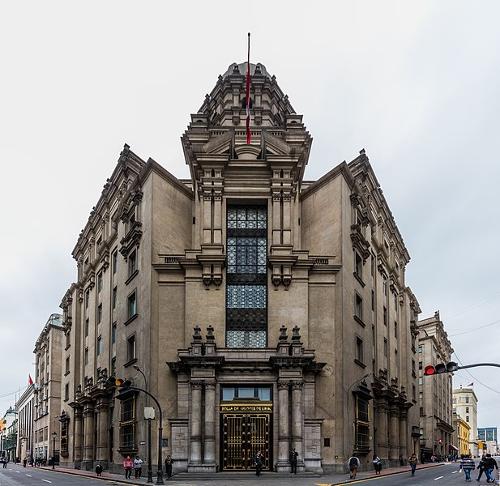 Stock Exchange Lima, PeruPhoto: Diego Delso CC by-sa/4.0 no changes made
Stock Exchange Lima, PeruPhoto: Diego Delso CC by-sa/4.0 no changes made
After a period of relatively stable economic development in the period 1965-1980, Peru faced an economic crisis. In the 1980s GDP grew by an average of 0.4% per year; per capita GDP declined by a total of 30% between 1981 and 1991. Since then, GDP has grown again by approximately 4% per year thanks to stabilization and adjustment policies. The period 1993-1997 in particular saw high growth rates. Economic growth was 2.5% in 2017.
Inflation was very high in the 1980s and 1990s. Inflation has now been below 5% for several years. (2.8% in 2017) The unemployment rate, officially 6.9% in 2017, is in reality many times higher: 22.7% of the population lives below the poverty line.
The informal sector is particularly large in Peru, mainly caused by high unemployment. One then works, for example, as a street seller or taxi driver. Peru joined the Andean Pact in 1969, a partnership between Bolivia, Colombia, Ecuador, Peru and Venezuela. The aim of this pact is to create a sub-regional common market. A cooperation agreement has existed since 1984 between the European Union and the countries of the Andean Pact. In 1991 an agreement was reached on the establishment of a free trade zone, initially between Venezuela, Colombia and Ecuador. Peru concluded bilateral trade agreements with most countries in the region. Peru has access to the Atlantic Ocean through Puerto Suarez, Bolivia's river port.
Agriculture, fishing, livestock and forestry
Less than 3% of the total land area is used for arable farming, 21% is pasture land and 54% is covered with forest. Due to climatic conditions, harvesting on the Peruvian coast is possible all year round.
Almost half of the arable land is irrigated, mainly in the irrigated areas in the Costa; the Sierra comprises 60% of the agricultural area, while in the Selva (now 15% of the area) large areas can still be made suitable for agriculture.
Of the products that are often grown on modern farms in the Costa, sugar cane and cotton are the most important, both products are exported; furthermore rice, grapes, tobacco, vegetables (broccoli, cauliflower, onions) and fruit (especially mangoes and also passion fruit and citrus fruit). Asparagus cultivation is a real growth sector and is already the main agricultural product for export. White asparagus mainly goes to Europe, the green variety is mainly frozen and exported to the United States.
The predominantly small companies in the highly cultivated Sierra produce food crops for the domestic market such as potatoes, beans, corn, bananas, wheat, oats, barley, tubers, quinoa and more and more export crops such as coca and coffee. In the Andes, a large part of the population lives from "subsistence agriculture". The Selva mainly produces cotton, rice, beans and bananas.
Peru is an important producer of the coca leaf. Although the bulk of the production of coca leaves and cocaine is currently concentrated in Colombia, the so-called "pasta básica", an intermediate for the final production of cocaine, is also produced in Peru and shipped to Colombia. This development means that, despite the reasonably successful fight against coca cultivation, coca farmers are becoming increasingly involved in drug crime.
Cattle and pig farming mainly takes place in the coastal plains (dairy production) and on the high plains in the Sierra; in the Sierra, sheep farming is predominant, in addition to alpaca and llama.
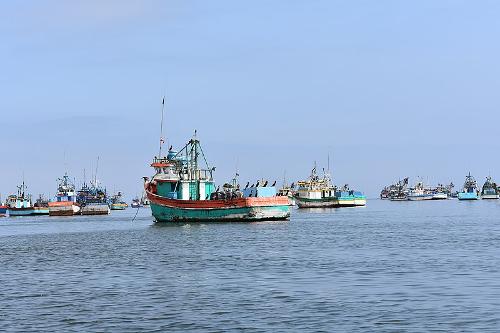 Peru FisheryPhoto:Jon Kolbert CC 4.0 International no changes made
Peru FisheryPhoto:Jon Kolbert CC 4.0 International no changes made
Sea fishing is of great economic importance. Peru is the country with the largest fish catch after China. After a sharp decline in the catches of anchovy and tuna in 1972 and 1982/1983 (as a result of overfishing and changes in the Humboldt current off the coast, which temporarily disappeared the fishing grounds), the fishery continued to recover.
Anchovies and sardines are largely processed into fish meal and fish oil. Peru is the largest fishmeal producer in the world. The rest of the fish, especially mackerel, is frozen or exported as preserves.
When El Niño occurs once every few years and warm tropical water flows along the coast, all the fish is gone and the fish processing industry is in crisis. The danger of overfishing has also been present for a long time, but quotas have been set since 1986.
Only a very small part of the available wood stock is exploited and in particular the production of hardwood is insufficient for domestic needs. About 8 million m3 of wood is felled per year for the wood processing industry. Expansion of forestry is a major priority, with particular attention to the transport problem. In the Sierra, wood is mainly used as an energy source, which has led to major ecological problems due to erosion.
Mining and energy supply
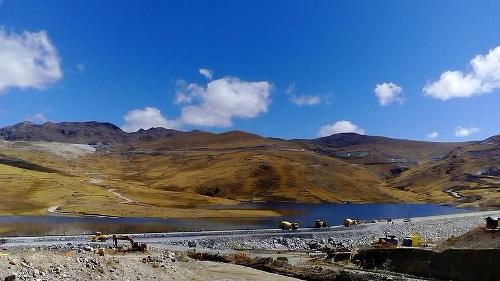 Coppermine PeruPhoto:Ondando CC 4.0 International no changes made
Coppermine PeruPhoto:Ondando CC 4.0 International no changes made
The exploitation of minerals is of great importance and mining is then one of the pillars of the economy. Traditionally, this sector accounts for about half of the country's total export earnings.
Peru has always been a major silver producer (second in the world rankings), ranking sixth in copper producers, fourth in zinc, lead and tin producers, while petroleum exports are a major contributor to foreign exchange receipts.
Mining was wholly owned by North American companies between 1906 and 1974. The largest share of copper extraction provide the Toquepala and Cuajone mines. Most of the copper ore is concentrated and smelted in Peru itself, and only half refined in the country. Other important copper mines are those of Tintaya (near Yauri), La Oraya and Cerro Verde.
Also important are the extraction of bismuth, gold, cadmium, selenium and a few other rare metals, often in combination with copper and zinc; iron ore is mined at Marcona. The extraction of uranium (one of the largest deposits in South America) at Marochoca (dept. Junín) is of great importance, as is (still) that of guano on some islands off the coast. Guano is the nitrate-rich bird manure on the rocks off the coast. The Sechura Desert provides potash and is home to one of the three largest phosphate reserves in the world.
Oil extraction, processing and sale has been partly owned by the state-owned company PETROPERÚ since 1968. Peru is self-sufficient for oil, one third is exported.
Oil production is gradually declining due to the depletion of existing fields and the lack of major new exploration activities.
The enormous hydropower reserve plays a major role in the energy supply of the country; 75% of the installed electrical capacity (approx. 14 billion kWh) consists of hydroelectric power stations (Río Mantaro; Huinco). The state electricity company ELECTROPERÚ manages most of the public electricity production and distribution, yet 35% of the population is without electricity.
Industry
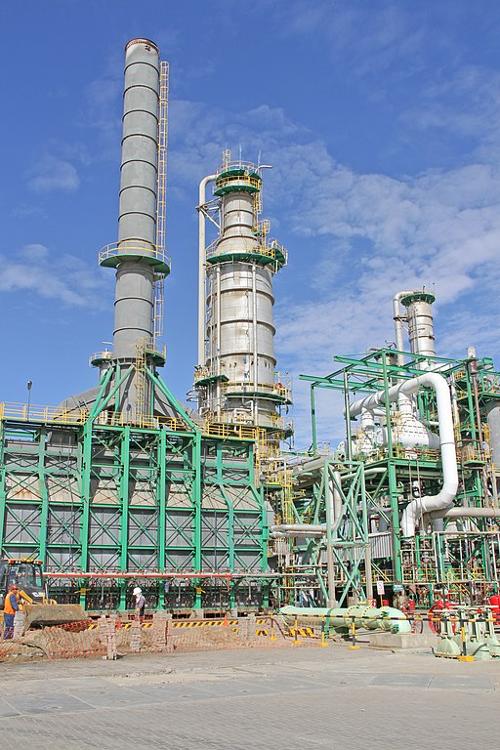 Refinery PeruPhoto: The EITI CC 2.0 Generic no changes made
Refinery PeruPhoto: The EITI CC 2.0 Generic no changes made
The processing of primary products from agriculture, mining and fishing still occupies an important place in the industry. The production of means of transport and electronics is also important. Despite industrial sector reform and nationalization since 1968, the influence of foreign capital has remained important and the influence of workers has been limited. State-owned and nationalized companies are managed by INDUPERÚ, founded in 1972, which also has the task of decentralizing industrial development.
Important industrial centers are:
- Lima-Callao is the country's industrial center: food, beverage, tobacco products, textiles, electronics, glass, rubber and cement Chimbote: fish meal, fish oil, canned fish, steel industry
- Chiclayo: sugar
- Trujillo: cars, tractors, machines, engines and sugar
- Arequipa: textiles and dairy products
- Cuzco: textiles, fertilizers
- Ilo: copper refining
- La Oroya: copper and zinc smelter, metallurgy
- Petroleum refineries in: Talara, Lima, Tumbes, Iquitos, Conchán, Pucallpa and Bayóvar
- Nazca: steel
CLOTHING AND TEXTILE
Textiles are the main branch of Peru's non-traditional exports, with the United States as its main export market. The success of Peruvian textiles is partly due to the very good quality of the cotton.
Trade
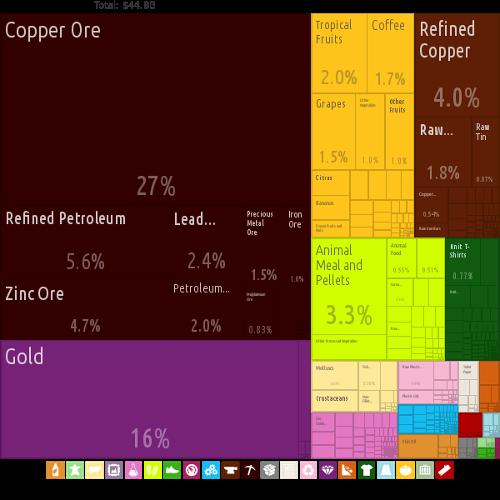 Export PeruPhoto: Alexander Simoes, Cesar Hidalgo, et. al CC 3.0 no changes made
Export PeruPhoto: Alexander Simoes, Cesar Hidalgo, et. al CC 3.0 no changes made
Today, cocaine (in the form of both powder and paste) is Peru's main export product alongside copper. The proceeds from cocaine are of course nowhere to be found in the official figures.
In addition to copper, silver, fishmeal, zinc, tin, coffee, iron and cotton are also important official exports.
The main trading partners are the United States, China, Canada, Japan and the EU, as well as neighboring countries to the Andean Pact.
Mainly raw materials, semi-finished products, machines and foodstuffs are imported.
Traffic
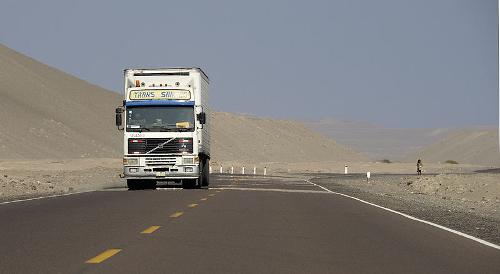 Pan American Highway PeruPhoto: Markus Leupold-Löwenthal CC 3.0 no changes made
Pan American Highway PeruPhoto: Markus Leupold-Löwenthal CC 3.0 no changes made
The geographic structure of the country causes major transportation problems. Most of the transport is by road. The length of the road network is approximately 80,000 km, of which only 15% is asphalted. The main arteries are the Carretera Panamericana (approx. 3400 km) from north to south largely along the coast, the Carretera Central Transandino, from Lima-Callao eastwards, which will connect to the Brazilian Transamazonian via La Oroya and Pucallpa in the future. highway, and the partly open to traffic, partly under construction Carretera Marginal de la Selva on the east side of the Andes mountains. Not so long ago, the Pan American's road surface was completely renewed and a toll system was introduced to pay for future maintenance.
The railway network (approx. 2500 km) consists of nine unconnected lines. Much of this is in a very bad condition and is mainly used for the transport of minerals.
Inland navigation mainly plays a role in the Amazon region (ports: Iquitos and Pucallpa) and on Lake Titicaca. Most of the imports and exports go through the seaport of Callao, about three quarters of all Peruvian imports and about a quarter of all exports; of the remaining 25 seaports of interest are Chimbote, Talara, Mollendo, Matarani, Ilo, Pisco, Salaverry, Bayóvar and Paita. The state shipping company Corporación Peruana de Vapores (CPV) has a merchant fleet of more than 600 ships, including about twenty tankers.
In addition to the international airports of Lima (Jorge Chávez), Iquitos, Artequipa and Cuzco, the country has over 300 airports and landing strips, seven of which are suitable for larger aircraft. The airline AEROPERÚ handles international air traffic and part of the domestic air traffic, the latter together with the private Faucett.
Sources
Le Grand, J.W. / Peru : mensen, politiek, economie, cultuur
Koninklijk Instituut voor de Tropen : Novib
Luft, A. / Peru
Elmar,
Lyle, G. / Peru
Chelsea House Publishers,
Peru
Cambium,
Peru, Bolivia
Lannoo
Rensink, E. / Peru
Gottmer,
Te gast in Peru
Informatie Verre Reizen
CIA - World Factbook
BBC - Country Profiles
Copyright: Team The World of Info